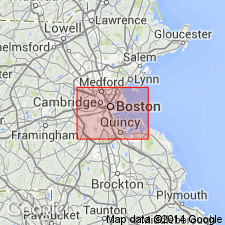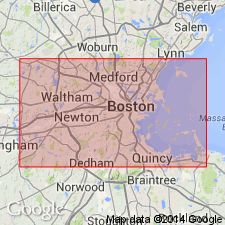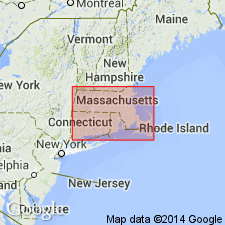
- Usage in publication:
-
- Somerville slate
- Modifications:
-
- Original reference
- Dominant lithology:
-
- Slate
- AAPG geologic province:
-
- New England province
Summary:
Pg. 196-197. Somerville slate. Is litholgically similar to recognized Cambrian slates of the [Boston] region and markedly disimilar to known Carboniferous rocks of neighboring areas, especially to those of Narragansett Basin.
Occurs at and around Somerville, Middlesex Co., eastern MA.
Source: US geologic names lexicon (USGS Bull. 896, p. 2026).

- Usage in publication:
-
- Somerville slates
- Modifications:
-
- Revised
- AAPG geologic province:
-
- New England province
Summary:
Pg. 316. Somerville slates, 2,300 feet thick, grade into underlying Sqantum tillite of Roxbury conglomerate through transition beds of shales or slates, sandstones, and conglomerates 200 to 300 feet thick. [Age is Carboniferous or Devonian.]
Source: US geologic names lexicon (USGS Bull. 896, p. 2026).

- Usage in publication:
-
- Somerville slate†
- Modifications:
-
- Abandoned
- AAPG geologic province:
-
- New England province
- Deerfield basin
Summary:
†Somerville slate. Mapped the rocks at and around Somerville, Massachusetts, as Cambridge slate and the name "Somerville slate" has been discarded.
Source: US geologic names lexicon (USGS Bull. 896, p. 2026).
For more information, please contact Nancy Stamm, Geologic Names Committee Secretary.
Asterisk (*) indicates published by U.S. Geological Survey authors.
"No current usage" (†) implies that a name has been abandoned or has fallen into disuse. Former usage and, if known, replacement name given in parentheses ( ).
Slash (/) indicates name conflicts with nomenclatural guidelines (CSN, 1933; ACSN, 1961, 1970; NACSN, 1983, 2005, 2021). May be explained within brackets ([ ]).

